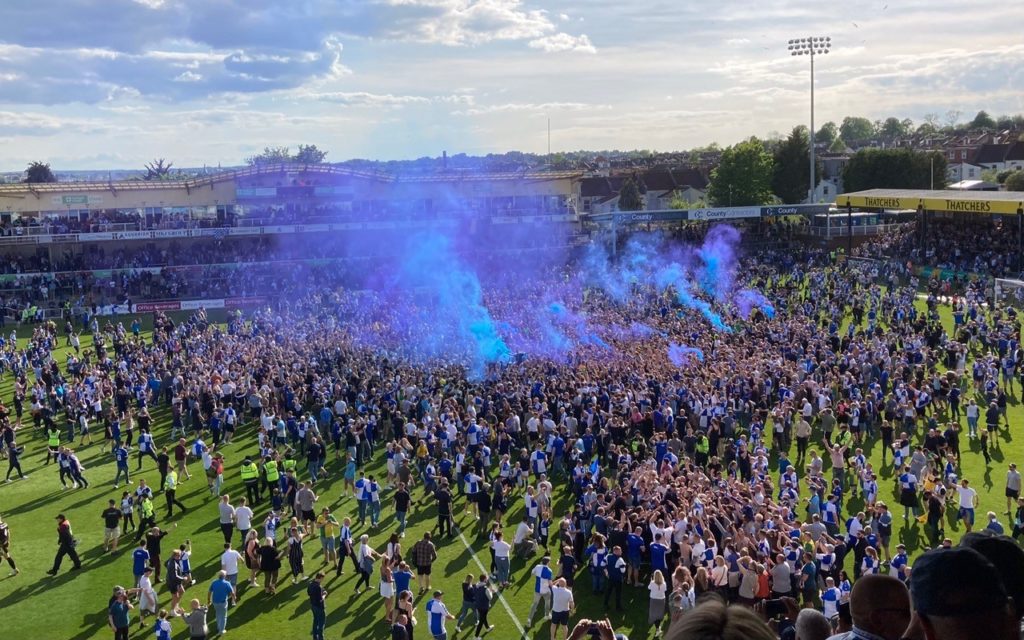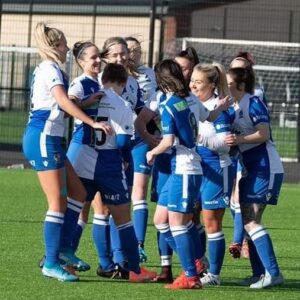And indeed, as the phrase of the season dictated, ‘The Gas are coming’. Having received eight red cards before the end of January (Harries received two of them), improved discipline saw no more issued beyond that point until Coutts was dismissed in the dying seconds of the penultimate game.
With this, the club began to play inspired football and results began to flow. Eighteenth after the home defeat to Newport County at the end of October, Rovers hit fourth place with a victory at high flying Northampton Town in mid March and a genuine promotion push emerged. This defeat of the Cobblers came courtesy of Harry Anderson’s goal after just 38 seconds. By the end of March, having won 11 of their past 17 League fixtures, Rovers had gained more points in 2022 than any other club in the Football League.
Following a defeat at Oldham, The Gas subsequently kept eight clean sheets in the next 11 matches, The Mem becoming a fortress where 14 League matches were won. It was little coincidence that this renewed form came after Rovers secured the signing of veteran Ipswich midfielder Jon Nolan and the loan acquisition of the precocious talent of Newcastle United teenager Elliot Anderson. ‘The Geordie Messi’ drew favourable attention from several larger clubs, not just for his seven League goals, each a gem in itself, but for his exciting all round play.
As the season drew towards a dramatic finale, Rovers fielded a very settled side and this certainly aided their rise up the League table. This lineup involved the reliable Belshaw playing behind a solid back four of Hoole, Taylor, Connolly and Anderton, captain Coutts patrolling the space in front of the defence, with a four man midfield of two Andersons, Evans and Finley supporting lone striker Collins.
Numerous options off the bench included the vast experience of Whelan and Leon Clarke with, as described by local reporter Sam Frost, ‘a battering ram in Loft and a pacy threat’ in Saunders offering very different attacking impact options. Josh Grant was able to cover in a wide range of positions throughout the season. One impressive return was the 4-0 win at Stevenage’s Lamex Stadium in February, thanks to goals from Finley, both Andersons and Collins, whose 16 League goals (despite not scoring a League goal until December) left him as the club’s top scorer for a campaign in which 33 players appeared in the League and 18 scored; 43 players were used in all competitions, of which 22 were making their league début for the club. The Stevenage game was one of a commendable nine away League victories.
There were, of course, precedents of clubs who had achieved dramatic promotions and, indeed, Bolton Wanderers in 2020 had also finished bottom of League One and immediately gained promotion in third place.
However, the manner of Rovers’ success was extraordinary and gained a great detail of attention in the national press. Similarities with the promotion gained through a final minute goal against Dagenham in 2016, six years to the day before the Scunthorpe game, were also clear to see. Rovers had accumulated just 45 points in the whole of 2021, yet 54 points from January to May 2022.
Two long term friends and opponents, Oldham Athletic and Scunthorpe United dropped through the trap door out of the Football League, The Iron playing their final fixture at The Mem in May. Their starting side that day had an average age of just 20 years 249 days (Rovers’ side at Wrexham in May 1979 had an average age of 20 years six days), and they included as a substitute Anthony Grant, who became the first opponent ever to play in the League against Rovers for eight separate clubs.
In defeating them 7-0 to reach 71 League goals for the campaign, Rovers had scored ten goals past The Iron this season, equalling club record seasonal totals against Doncaster Rovers in 1956/57 and Reading in 1998/99. League doubles were achieved over Walsall, Harrogate, Crawley, Northampton, Rochdale and Scunny, whilst only Newport County completed a League double over Rovers.
Rovers’ defence kept four clean sheets during the first half of the season and 13 in the second, including four in a row in February. There were no ever presents, but Collins played in 45 League games, with Player of the Season Belshaw, club captain Coutts, Young Player of the Season Taylor and Harry Anderson all also appearing in forty or more. Pitman, Evans, Collins and Coutts all scored from the penalty spot in League and Cup.
Numerous former Rovers players appeared against The Gas during the campaign. Bereft of the suspended Ed Upson for their late October visit to The Mem, Newport County nonetheless fielded four former Rovers players in Timmy Abraham, Joe Day, James Clarke and Dom Telford (who scored twice in a 3-1 win), whilst veteran striker Kevin Ellison’s brief cameo appearance as a late substitute meant that, at 42 years 242 days, he became the third oldest opponent to face Rovers in the Football League.
Oldham Athletic’s Davis Keillor-Dunn scored against Rovers at Boundary Park in February after just 42 seconds. Former manager Darrell Clarke returned to win at The Mem in December with his Port Vale side, whose captain Tom Conlon is the great great grandson of Albert Pearson (1892-1975), who had played for Llanelli against Rovers’ reserve side in the Western League during the 1922/23 season.
Crawley’s goalkeeper Glenn Morris played against Rovers, having also appeared against The Gas with Orient in 2002, the fifth longest gap of any opponent between their first and last appearance in the League against the side.
Similarly, Tranmere opposed Rovers in April, starting with two players aged over 40 (the first time Rovers have ever played a side including two opponents past their 40th birthday). Having used two experienced substitutes, Tranmere ended this match with an average age on the field of just over 30, the highest in years but well short of the Ipswich Town side of December 1948, whose average age was over 34.
Whelan was Rovers’ fourth oldest League debutant and became, on the final day, Rovers’ fourth oldest League player ever, whilst Leon Clarke and Spence became only the sixth and seventh players to score as substitute on their first Rovers appearances.
Referee Nick Dunn was replaced by Lee Swabey, because of injury, just before half time at Crawley in March. Barrow’s Kgosi Ntlhe became the seventh South African international to play in the League against Rovers and Oldham’s Dylan Bahamboula the fourth who had represented Congo to do so.
Barrow had a man sent off in both League fixtures against Rovers, seven opponents seeing red during the campaign. Luke Hendrie, who played in Bradford City’s 2-1 defeat at The Mem in April, is the great nephew of former Rovers midfielder Paul Hendrie.
The late season derby against Forest Green Rovers, whose well earned point secured their first ever promotion to third tier football, was watched by a crowd of 9,690 and one hundred more, the highest home attendance of the season, watched the final day demolition of Scunthorpe. Conversely, only 889 saw Cheltenham’s Football League Trophy visit and there were just 1,740 at Salford City, when Rovers played there in November. Boosted by enormous, raucous and expectant crowds for the final two games of an exhilarating campaign, Rovers’ average home League attendance for the season was 7,512.
Meanwhile, Rovers’ women’s side was hugely successful, earning promotion as champions of the South West Women’s Regional League Division One North, a title secured through four second half goals against Weston Mendip Ladies at Lockleaze in February.
Amongst several eye catching scores was an 8-0 victory over Weston-super-Mare in which Laura Curnock and Zoë Fielden-Stewart scored four goals each. On April 23rd, the men’s team and women’s team both played at home, in a historic double header.
Sadly, Audrey Butler (1941-2021), who dressed as Captain Gas for many years to entertain the crowds prior to home fixtures, died in the week between Christmas and New Year.
Two classic cup ties saw Rovers defeat higher tier Oxford United in the FA Cup first round. First, two equalisers, the second being a late penalty from Evans, earned the Gas a draw at the Kassam Stadium; then Rovers recovered from 3-1 down with ten minutes to play, substitutes Spence (two) and Collins scoring in a sensational 4-3 victory, Matty Taylor having scored against his former club in both games (his penalty in November being the final one Rovers conceded all season) and fellow former Pirate Billy Bodin also scoring in the replay.
Many viewed Rovers’ extra time recovery as a critical turning point in a dramatic season. Rovers subsequently defeated Sutton United at home, before losing to Peterborough United in the third round, the winning goal coming 27 minutes from time from a mazy run by Posh substitute Bali Mumba.
Crashing out of the League Cup at home to Cheltenham Town, Rovers managed just one shot on target. Former Rover Andy Williams played for Cheltenham as Rovers gaining some degree of revenge, the Robins being defeated in the Football League Trophy.
Stephen Byrne
All photos courtesy of Keith Brookman and Rich Buchanan






